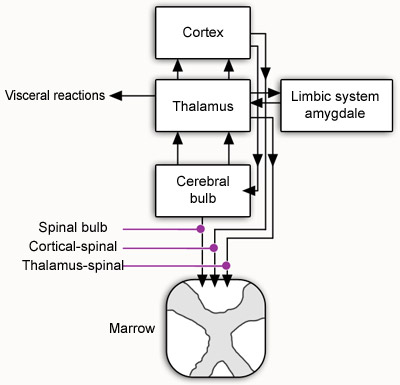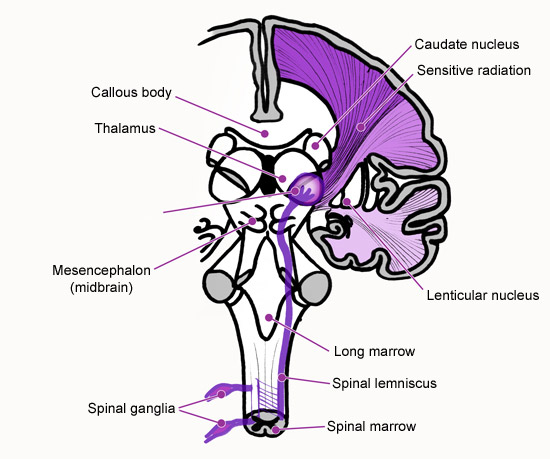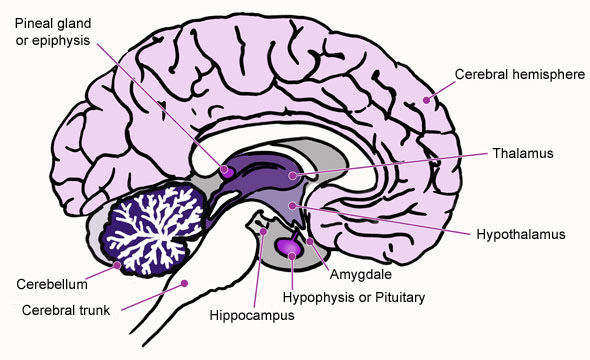Asclepius' Ampoule - Pain and emotions
By Roberto Merante, physician and TCM instructor, and William Giordano, certified massage therapist
A melancholic atmosphere was surrounding the club like a thick fog, darkening sight and mind at once. We were remembering our dear friend who had died of a sudden stroke. Wilhelm and I were trying to focus on a chess game to divert our minds from the sad thoughts that were clouding it.
All of the sudden while moving a bishop Will cried out, "How is it possible that an emotion like sadness can become so strong to produce such an intense pain?"
"When facing these emotions our brain generates the only alarm it knows: pain. On the other hand we need to remember that those feelings are always generated in the Hypothalamus. This, in fact, is the center that regulates all the principal life's functions and it modifies them in order to adapt them to the stimuli received by the body. From this perspective emotions are but stimuli to which the brain responds. It is no surprise – therefore – that fear and sadness are read as signals of danger for the person's life itself"
"But how can it face alone such a complex system like the emotional lived experience of a person?"
"This task belongs to a section of the temporal lobe – the amygdale – which sends messages depending on what it receives from the cerebral cortex. Despite this, simple medical means are not sufficient to solve the complexity of the problem. What do you think about it Will?" (1)
After pouring a cup of tea, dropped a sugar cube in it and blown over the hot beverage, he replied,
"Emotion. Such a small word, filled with such an immense and powerful significance that it interacts with every moment of our lives; one cannot do absolutely anything without generating emotions such as love, hate, fear, happiness, sadness, resentment and all the rest. They are but energy brought up to surface which expresses the continuum of life. Emotions hold the power to make us feel alive. Our thoughts, negative or positive they may be, arm in arm with actions and with the materiality of things we interact with, give energy to life, give a meaning to everything we live, breaking up the monotony that the lack of emotions would generate. Emotions are the core of the energy created by our experiences, without which we could not value what we do, what we see and feel. How could love exist without emotions? What would be the meaning of a scent, of a beautiful woman, of a good action, looking at the sun or go on a boat trip on a blue sea watching happy dolphins jumping?"
"Right. As usual with your poetic spirit you talk about the meaning emotions give to life. Yet things are not always so smooth"
"When the famous slate falls right on our head and things start to go wrong our emotions – in a negative phase – can harm us quite a bit; they can distort reality and make us feel pain. Pain and suffering, two words nobody wants to meet ever, and yet they are so connected with emotions. Pain for the loss of a loved one, pain because we were victims of a mischief, pain for having been defeated, pain to see other people's suffering, physical pain or pain for not being able to be who we wish to be. All these situations make us understand how important emotions can be. Emotions that, if not kept under control, can lead us to see life in a very negative way, distorting its real meaning."
At this point he stopped and started sipping his tea. Something told me not to interrupt his thoughts.
He continued, "Pain, like happiness, finds its ultimate expression in an illness. What else could be as devastating and – at the same time – as consciously destabilizing as suffering or as the loss of our own or a loved one's physical health? What else could be as direct to give us an idea of how important it is to feel well, to enjoy our body and all the tools it was given, its lightness and potentials? Sometimes we are so taken by our job and by everyday things that we almost forget to be equipped with such a perfect machine, neglecting to give it the importance and value it deserves. We only notice it when it starts complaining, when it forces us to slow down, to go to the mechanic and adjust a couple of screws…"
Di nuovo si arrestò. Era come se le parole ed i pensieri fossero due binari che non volevano incontrarsi.
"Il dolore o sofferenza trovano forse la loro massima espressione nell'esperienza della malattia, cosa c'è di più devastante e nello stesso tempo di più consapevolmente destabilizzante della sofferenza e della perdita della salute fisica nostra o di una persona cara, cos'è che ci può dare un'idea di quanto sia importante sentirsi bene, godere del nostro corpo e di tutti gli strumenti di cui esso è fornito, della sua leggerezza e potenzialità, a volte presi dal lavoro dalle cose di tutti i giorni ci dimentichiamo quasi di essere dotati di una macchina perfetta e non gli diamo quell'importanza che merita, ce ne accorgiamo soltanto quando incomincia a fare le bizze e a picchiare in testa costringendoci a rallentare e andare dal meccanico a tirare qualche bullone..."
"I am glad to be man's mechanic – I replied – One can adjust the body by regulating its natural balance… Yet to heal a person is much more complicated"
Wilhelm's eyes started to glitter, "I want to share with you a letter written by my brother when he was recovering from a difficult surgery"
As he was handing me the sheet I had the impression that his hand was trembling.
"My goodness, this time it really wasn't looking good… I thought that was it: specialists, tests, hospitals. Then that day when I entered surgery and laid down on the bed I prayed and asked for help. Fear and solitude had control over me, I thought I was not gonna make it, and instead I am here to tell you this story. At 50 I realized how much wealth and beauty I had, yet I always took everything for granted… now I am here walking on the beach, the sea is incredibly blue, a gentle breeze is blowing and on the horizon the sun is slowly falling, dyeing everything with an orange tint… how emotional guys… how amazing to be still alive."
I gave him back the letter, deeply touched by it. I hugged him and walked away in silence.
For that evening all had been said.
Further readings
1.
Nervous structures involved in the perception of pain recognize a main axis of connections made of three parts
Peripheral receptors sending impulses to central structures. These receptors receive an external stimulus like pressure, traction, heat, etc.
The second processing center, the Thalamus. Here peripheral impulses are processed in order to discern if they are to be read as painful sensation depending on their extension, duration and intensity. If the result is affirmative the Thalamus sends impulses to the cerebral cortex.
Cerebral cortex. It receives impulses from the periphery in order to identify the seat of perception and from the Thalamus in order to recognize perceptions of pain. That's where our conscious perception takes place.
Next to this main axis there are structures that condition pain receptivity. Those nervous structures are regulated by internal factors (emotional state, health condition, etc.) and by the environment in which we live (an emotional state like anxiety, intended as a pre-warning condition of the organism, is just the response to a context perceived as dangerous or hostile).
The response to a painful stimulus involves first of all conscious structure belonging to cortical type, especially the frontal areas where our conscience resides. More particular is the involvement of deeper structures: the hypothalamus hormonally controls the internal balances of the body and stimulates the defense mechanisms by activating the sympathetic system and increasing the secretion of adrenaline (defense reaction). The hypothalamus is, in fact, the center that ensures the coordination of the corporal components of each emotional state.
The amygdale (one of the most ancient structures of our brain, from an evolutionary perspective) carries out a key role together with the limbic system in generating emotions. It interferes with the above mentioned nervous structures, facilitating or inhibiting its functions. In particular its action on the thalamus regulates pain threshold. In other words, a happy and serene man will have a high pain threshold because, on a thalamic level, stimuli will need to be quite strong to set off the feeling of pain. The opposite will happen to a sick or sad person, who will perceive as hostile the environment where he/she lives.
Illustrations

Fig. 1 - Main axis layout, periphery-thalamus-cortex

Fig. 2 - Transversal section of the brain, depicting the spinal-thalamus-cortical way.

Fig. 3 -Longitudinal section of the human brain.